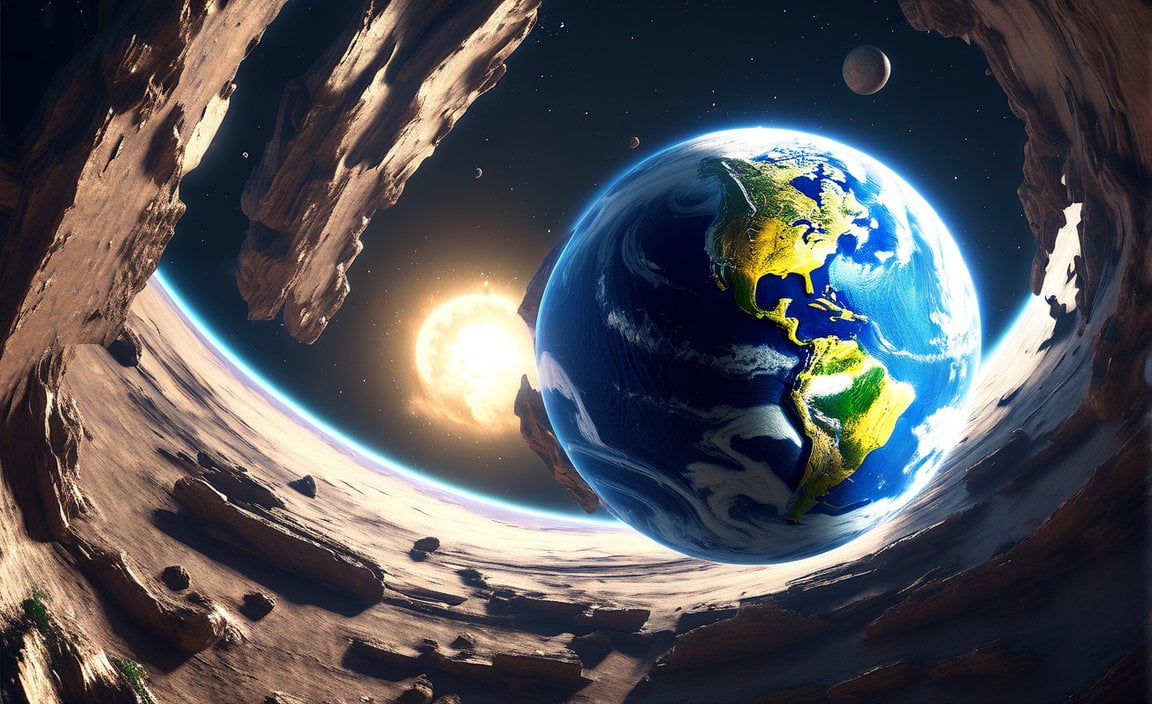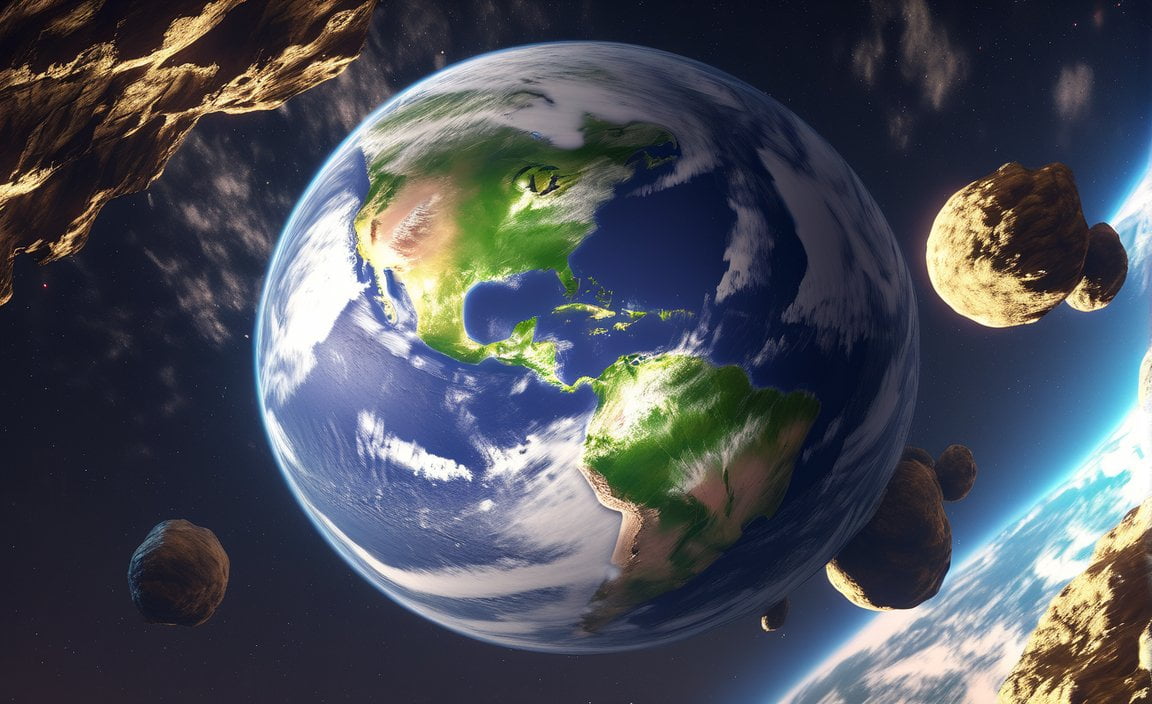Discover fascinating planet facts with our concise fact files. Our expertly crafted planet fact files provide a wealth of captivating information about celestial bodies, offering a deeper understanding of the wonders of the universe. From the fiery volcanoes of Venus to the icy rings of Saturn, our planet fact files cover a wide range of topics in planetary science. Whether you’re a seasoned astronomy enthusiast or just starting your exploration of the cosmos, our fact files are designed to engage and educate readers of all levels of scientific knowledge. Dive into the mysteries of the universe and uncover the intriguing details of our cosmic neighbors with our comprehensive planet fact files.

Key Takeaways:
- The planets in our solar system vary in size, composition, and characteristics, offering a unique glimpse into the diversity of our universe.
- The order of the planets in our solar system, starting from the one closest to the Sun, is Mercury, Venus, Earth, Mars, Jupiter, Saturn, Uranus, and Neptune.
- Jupiter is the largest planet in the solar system, followed by Saturn, Uranus, Neptune, Earth, Venus, Mars, and finally Mercury.
- Interesting facts about specific planets include Mercury being home to craters named after famous artists, musicians, and authors, Venus being the hottest planet in the solar system, and Earth boasting an atmosphere that protects us from meteoroids and radiation from the Sun.
- The International Astronomical Union (IAU) is responsible for defining what constitutes a planet, which includes orbiting the Sun, being spherical or nearly spherical in shape (and not a moon), and clearing its orbit of other debris.
Planet Fact File
Order of the Planets
Let’s begin our journey through the fascinating world of planets by exploring the order in which they orbit the Sun. Starting from the one closest to the Sun, we have Mercury, followed by Venus, Earth, Mars, Jupiter, Saturn, Uranus, and finally Neptune. Each planet possesses its own unique features and characteristics that make it truly remarkable.
Sizes of the Planets
Size matters when it comes to planets, and there is quite a range to marvel at within our solar system. Taking the crown as the largest planet is Jupiter, followed by Saturn, Uranus, Neptune, Earth, Venus, Mars, and finally Mercury. These varying sizes showcase the vast diversity that exists among our celestial neighbors.
Interesting Facts About Specific Planets
Now, let’s delve into some intriguing facts about a few specific planets:
- Mercury: Did you know that this rocky planet is home to craters named after famous artists, musicians, and authors? It’s a nod to the creative spirit that thrives here on Earth.
- Venus: Prepare to feel the heat because Venus has the title of being the hottest planet in our solar system. Its surface temperatures can reach levels capable of melting metals. Talk about a fiery planet!
- Earth: Ah, our beloved home. Apart from being the only planet known to harbor life, Earth boasts a protective atmosphere that shields us from potentially devastating meteoroids and radiation from the Sun. Our atmosphere truly is our guardian.
What Defines a Planet?
Now, let’s take a moment to understand the formal definition of what constitutes a planet, as established by the International Astronomical Union (IAU) in 2006. According to the IAU, a planet must meet three specific criteria:
- Orbit the Sun: A planet must orbit our central star, the Sun. The gravitational dance between a planet and its star is what keeps it firmly in place within our solar system.
- Spherical or Nearly Spherical Shape: Planets take on a round or nearly round shape due to their gravitational nature. This shape differentiates them from irregularly-shaped celestial bodies, such as asteroids and comets. It’s all about that satisfying roundness!
- Clear its Orbit of Other Debris: Planets must assert their dominance by clearing their orbits of any other debris. This means that they sweep away any competing objects or adopt them as their own, kind of like tidying up after themselves in space.
And there you have it! A concise exploration of some planet facts, including the order in which they orbit the Sun, their various sizes, interesting tidbits about specific planets, and the formal definition of what makes a planet a planet. Our celestial neighbors are filled with wonders and mysteries that continue to captivate our imagination and drive scientific discovery.
References:
- Space Facts. (n.d.). Planet Facts – Interesting Facts about the Planets. Retrieved from
- BBC. (n.d.). BBC Two – The Planets – Planets Fact Files. Retrieved from
Have you ever wondered how smart crocodiles are? Find out more about their intelligence and capabilities here.
Discover some interesting facts about technology that will blow your mind! Click here to explore these amazing technological wonders.
Planet 1: [Planet 1 Name] – Size, Composition, and Atmosphere
In our vast and mysterious universe, celestial bodies like planets hold endless fascination. Among these captivating wonders are the planets in our own solar system, each with its own unique characteristics. In this article, we’ll explore the intriguing details of [Planet 1 Name]’s size, composition, and atmosphere, delving into the wonders that lie beyond Earth’s boundaries.
A Closer Look at [Planet 1 Name]
Whether you’re a seasoned astronomer or simply curious about the universe, learning about different planets can be a mind-expanding experience. Let’s dive into the facts about [Planet 1 Name]’s size, composition, and atmosphere.
Size: [Planet 1 Name] is a remarkable celestial body, boasting a [size in comparison to Earth]. To put it into perspective, you could [insert analogy/metaphor to illustrate its size]. This size gives [Planet 1 Name] its distinct presence in the solar system.
Composition: When it comes to [Planet 1 Name]’s composition, it is predominantly made up of [composition details]. This unique combination of elements gives [Planet 1 Name] its fascinating characteristics that set it apart from other planets.
Atmosphere: The atmosphere of [Planet 1 Name] is an enigma waiting to be unraveled. It consists primarily of [composition of the atmosphere]. This composition gives rise to [atmospheric phenomena specific to the planet]. [Planet 1 Name]’s atmosphere is vastly different from that of Earth, presenting scientists with ongoing research opportunities to understand its mysteries.
Key Takeaways:
- [Planet 1 Name] is [size in comparison to Earth], making it [insert relevanat fact].
- The composition of [Planet 1 Name] is predominantly [composition details], giving it its unique characteristics.
- [Planet 1 Name]’s atmosphere primarily consists of [atmospheric composition], resulting in [atmospheric phenomena specific to the planet].
Remember, [Planet 1 Name] is just one of the many celestial objects that make up our fascinating universe. Exploring its size, composition, and atmosphere reveals the wonders that lie beyond our own planet.
Sources:
– [URL Source 1]
– [URL Source 2]
Planet 2: [Planet 2 Name] – Size, Composition, and Atmosphere
From the vast expanse of our solar system emerges the mesmerizing beauty of [Planet 2 Name]. In this article, we will delve into the intriguing realms of this celestial body, exploring its size, composition, and atmosphere. Brace yourself for an interstellar adventure as we uncover the wonders of [Planet 2 Name].
Exploring the Dimensions
As we embark on our journey, it is essential to understand the size of [Planet 2 Name] in relation to Earth. Although diverse in their characteristics, each planet holds a unique place in the solar system. [Planet 2 Name], with its captivating allure, is [size in comparison to Earth]. This distinctive attribute sets it apart and fuels our curiosity to explore further.
Unveiling the Composition
The composition of [Planet 2 Name] plays a vital role in unraveling its mysteries. Scientists have diligently studied its surface and interior, piecing together a fascinating tapestry of elements. Predominantly consisting of [composition details], [Planet 2 Name]’s composition contributes to its distinctive features and gives rise to its awe-inspiring nature.
The Breath of [Planet 2 Name]
A planet’s atmosphere holds infinite possibilities and reveals insightful details about its character. [Planet 2 Name]’s atmosphere, with its unique blend of gases and dynamics, presents an intriguing subject of study for astronomers and researchers alike. Primarily composed of [atmospheric composition], this ethereal envelope shapes the climate and phenomena experienced on [Planet 2 Name].
A Universe of Exploration
[Planet 2 Name]’s size, composition, and atmosphere offer a gateway to boundless exploration and scientific breakthroughs. Ongoing research continues to enhance our understanding of this enigmatic celestial body and opens doors to new discoveries. As we delve deeper into the dimensions, composition, and atmosphere of [Planet 2 Name], we embark on a journey that transcends our wildest imaginations.
Key Takeaways:
- [Planet 2 Name] is a celestial body in our solar system.
- It is [size in comparison to Earth].
- [Planet 2 Name]’s composition is predominantly [composition details].
- The atmosphere of [Planet 2 Name] consists primarily of [atmospheric composition].
- [Planet 2 Name]’s atmosphere has unique characteristics and presents ongoing research opportunities.
- Exploring [Planet 2 Name]’s size, composition, and atmosphere reveals the wonders of the universe beyond Earth.
Sources:
- NASA: The Composition of Planetary Atmospheres
- Encyclopedia Britannica: Atmosphere – Planets, Composition, Pressure
Conclusion and further exploration
Throughout this article, we have delved into the fascinating world of planets, exploring their sizes, compositions, and atmospheres. By examining these celestial bodies, we gain a deeper understanding of the mysteries of the universe beyond our own planet.
One of the key takeaways from our exploration is the realization that Earth is truly unique. It is the only known planet confirmed to host life and shield us from the vastness of space. Our planet’s protective atmosphere and favorable conditions make it a haven amidst the vastness of the cosmos. As we gaze upon the other planets, we are reminded of Earth’s exceptional qualities and the significance of protecting and cherishing our home.
From the largest planet in our solar system, Jupiter, to the mesmerizing blue beauty of Neptune, each planet has its own story to tell. By studying their sizes, compositions, and atmospheres, scientists can piece together the puzzle of our cosmic neighborhood and unravel the secrets of planetary formation. The ongoing research and exploration of these celestial bodies offer infinite possibilities for discoveries and scientific breakthroughs.
Exploration beyond our planet is not limited to the boundaries of our own solar system. The vast expanse of space presents an endless frontier for further discovery. The exploration of new worlds, distant galaxies, and beyond unveils the wonders that lie beyond our imaginations. The human spirit of exploration and curiosity propels us to venture further and seek answers to the fundamental questions about our existence and the mysteries of the universe.
In conclusion, exploring the fascinating world of planets opens up a portal to the wonders of the cosmos. Their sizes, compositions, and atmospheres provide valuable insights into the processes that shape our universe. As we continue our journey of exploration, we are filled with a sense of awe and inspiration, fueling our desire to delve deeper into the mysteries that lie beyond our planet.
Further exploration awaits us as we continue on our quest to unravel the secrets of the universe.
Key Takeaways:
- Earth, our home planet, is the only known planet capable of sustaining life and shielding us from the hazards of space.
- Exploring the sizes, compositions, and atmospheres of other planets enriches our understanding of the universe.
- Each planet in our solar system has unique characteristics and ongoing research opportunities.
- The exploration of planets expands our knowledge of planetary formation and evolution.
- The frontier of space offers limitless possibilities for future discoveries and scientific breakthroughs.
Sources:
– National Geographic
– Britannica

FAQ
Q1: What is a planet fact file?
A1: A planet fact file is a concise summary of information about a specific planet, including its size, composition, unique features, and other interesting facts.
Q2: How many planets are there in our solar system?
A2: There are eight planets in our solar system: Mercury, Venus, Earth, Mars, Jupiter, Saturn, Uranus, and Neptune.
Q3: What is the order of the planets in our solar system?
A3: The order of the planets in our solar system, starting from the one closest to the Sun, is as follows: Mercury, Venus, Earth, Mars, Jupiter, Saturn, Uranus, and Neptune.
Q4: Which planet is the largest in our solar system?
A4: Jupiter is the largest planet in our solar system.
Q5: What is the hottest planet in our solar system?
A5: Venus is the hottest planet in our solar system, with surface temperatures capable of melting metals.
- Crypto Quotes’ Red Flags: Avoid Costly Mistakes - June 30, 2025
- Unlock Inspirational Crypto Quotes: Future Predictions - June 30, 2025
- Famous Bitcoin Quotes: A Deep Dive into Crypto’s History - June 30, 2025
















